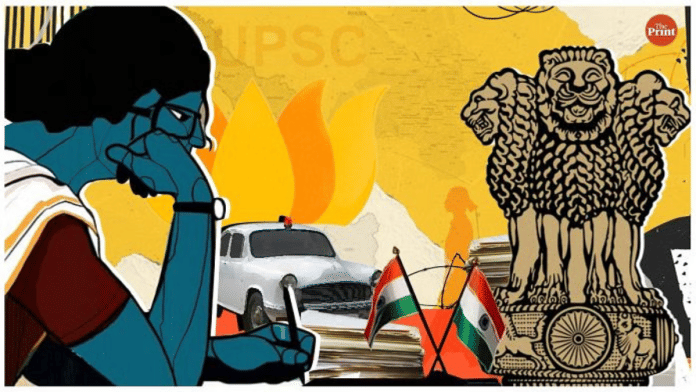New Delhi: Last month, the central government appointed the 1994-batch IAS officer Anuradha Thakur as the secretary of the Department of Economic Affairs (DEA). A first for a woman, the high-profile position has been occupied by the likes of former prime minister Manmohan Singh and former deputy chairman of the Planning Commission, Montek Singh Ahluwalia.
But, Thakur is hardly a rare breed these days. The number of women currently posted as secretaries at the Centre is 16 out of 90—almost 18 percent. According to retired IAS officers, who joined the service in the early 80s, the figure is higher than the total percentage of women officers who were recruited in the Indian Administrative Service (IAS) during their time.
“I don’t recall it being more than 10-12 percent,” says Aruna Sharma, a retired IAS officer of the 1982 batch.
Health, corporate affairs, consumer affairs, Department of Personnel and Training (DoPT), water resources, legal affairs are some of the key areas of administration now headed by women secretaries.
The change is palpable at lower levels, too. According to data from October 2024, approximately 64 out of the 236 joint secretaries—27 percent—serving in the government, were women.
At the state level, it is the opposite. Only 2 of the 36 officers serving as chief secretaries in states and Union Territories, are women—Alka Tiwari, Jharkhand (1988 batch) and Dr. Shalini Rajneesh, Karnataka (1989 batch).
Leena Nair, a retired officer of the 1982 batch, said the change started taking place from 2015-16 onwards. “We were merely 10 percent of us in the batch, but there was a time when 14 of us became secretaries,” she said. “There was a palpable change when the bias of postings faded, and the attitude was that if you have proved your credentials, you could get the posting.”
A steady rise
Indeed, there has been a steady rise in the number of women recruited since 1951 when Anna Rajam Malhotra became the first woman IAS officer.
According to the Indian Administrative Service Officers dataset compiled by the Trivedi Centre for Political Data (TCPD) at Ashoka University in 2020, in the 50s, the number of women recruited hovered around 5 percent. By the 70s, it increased to 15 percent, 25 percent in the 2000s, and 27 percent by 2020.
“The numbers you see at higher posts now is simply a result of more and more women joining the IAS and other services,” said a senior IAS officer. “My batch has 25 percent women officers. That means one out of every four people is a woman. So, for younger people to have a woman boss is no longer a rare occurrence.”
“You are slowly also seeing the posting bias fade away. You don’t have women posted in just WCD (Women and Child Development) or social justice anymore,” she said.
According to the latest data, the secretary posts occupied by women include, the President’s secretary, science and technology, legal affairs, labour, health, department of posts, chemical and petrochemicals, animal husbandry and dairying, among others.
“Back in the day, we faced enormous biases when it came to postings,” said Nair. “Forget about secretaries, women were not even made DMs. They were confined to the secretariats.”
“There was a geographical dimension to this. In states like Tamil Nadu or Kerala, you saw women rise to the top. In states like Haryana, Punjab, even a DM was unimaginable,” she recalled.
However, according to Sharma, the “glass ceilings” for women officers began to break in the 1970s itself, when a few women began to get appointed as chief secretaries and secretaries.
“They were very few in numbers, but they started paving the path. Over the years, we have seen a greater number of women make it to the IAS and other services, and that too, at a younger age,” she said. “That has ensured they rise to the top in greater numbers.”
Long way to go
However, biases still exist. “Women are yet to get some of the top notch posts like cabinet, home, defense, secretary,” Nair said. “Perhaps, it is a matter of time.”
But biases exist at the state level, too. According to data analysed by ThePrint, as of 2022, while the number of women entering the IAS through the UPSC’s Civil Services Examination was at around 30 percent since 2014, the percentage of women given the all-important posts of district magistrates or DMs was no more than 19 percent. According to the data compiled from different state government websites, only 142 out of 716 districts analysed had women posted as DMs.
Moreover, according to the data analysed, of the 47 districts categorised as affected by Left-Wing Extremism (LWE) until 2021, only seven were headed by women.
“There is a long, perhaps endless, way to go when it comes to complete parity,” said the IAS officer quoted above. “Being an officer requires immense hobnobbing with all kinds of people. The ability of a woman to go and get a drink with a male politician is severely restricted in comparison to her male counterparts,” she said. “A lot of benefits and favouritism flows from these informal networks which are simply not open to women.”
“Then, there are obviously the issues of marriage and parenting,” she added.
In March, Sarada Muraleedharan, who was then serving as the chief secretary of Kerala, took to social media to call out the prejudice faced by her for being a dark-skinned woman even when she occupied the top post of the state bureaucracy.
“Heard an interesting comment yesterday on my stewardship as chief secretary-that it is as black as my husband’s was white…It was about being labelled black (with that quiet subtext of being a woman), as if that were something to be desperately ashamed of,” she wrote.
(Edited by Tony Rai)
Also Read: After an all-time low representation, 60% of new joint secretaries are from IAS






